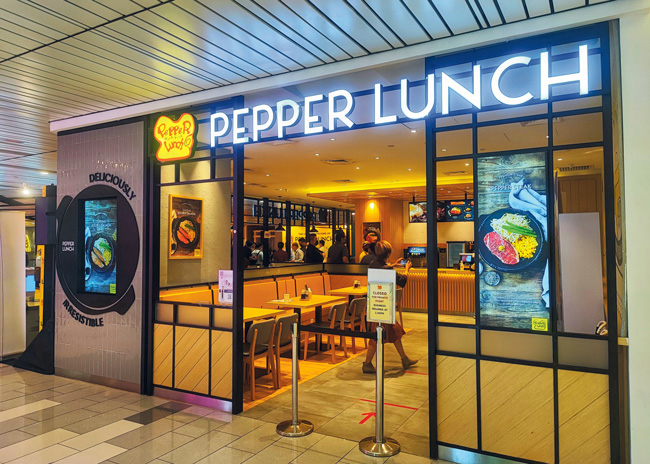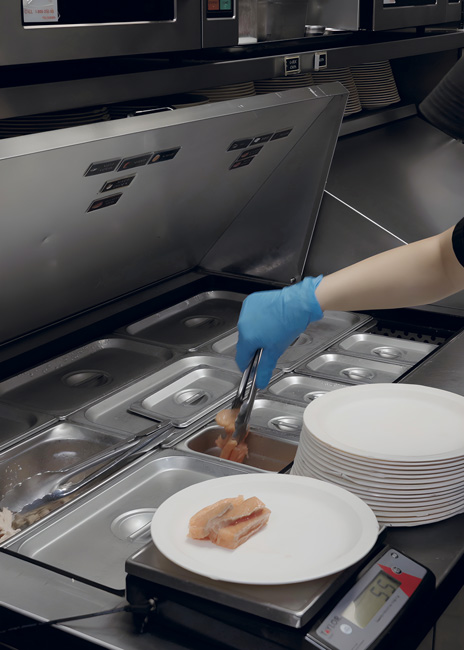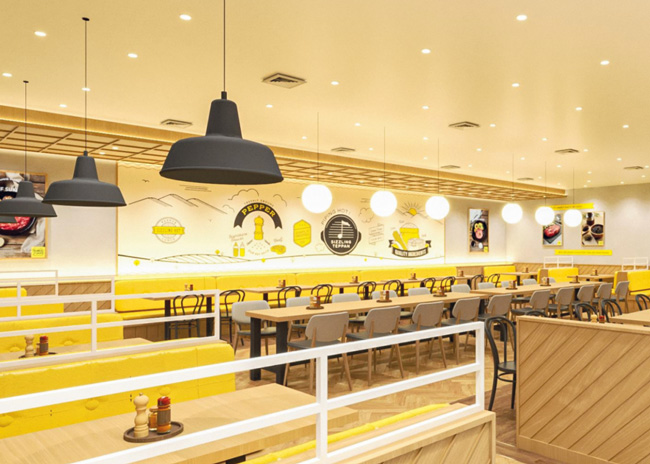Established in Asia, this DIY teppanyaki concept is looking to become a player in the U.S. chain restaurant scene.
 For the most part, the typical fast-casual experience is a little light on the experience component. Concepts in the space put out good food quickly, but they’re not places you tell your friends about visiting.
For the most part, the typical fast-casual experience is a little light on the experience component. Concepts in the space put out good food quickly, but they’re not places you tell your friends about visiting.
Asian concept Pepper Lunch sees an opening here. By creating an Instagram-worthy outing, the chain aims to grow from six U.S. locations today to a few hundred in just a few years.
This isn’t just wish casting. Pepper Lunch may be an emerging concept in the U.S., but it’s got an overseas track record that proves it can succeed on a large scale.
DIY History
 The chain’s proprietary iron plates are heated to 500 degrees F, allowing guests to cook their food at the table. A paper bib helps prevent burns and splashes.Born in Japan nearly 30 years ago, the chain takes its name from beef pepper rice, a staple dish in Japanese home cooking, says Troy Hooper, North American CEO of Hot Palette America, Pepper Lunch’s parent company in the U.S.
The chain’s proprietary iron plates are heated to 500 degrees F, allowing guests to cook their food at the table. A paper bib helps prevent burns and splashes.Born in Japan nearly 30 years ago, the chain takes its name from beef pepper rice, a staple dish in Japanese home cooking, says Troy Hooper, North American CEO of Hot Palette America, Pepper Lunch’s parent company in the U.S.
Pepper Lunch today has more than 500 locations, primarily in East Asia. DIY teppanyaki essentially serves as the heart of the experience, says Hooper.
“There are a lot of Asian concepts, from hibachi and teppanyaki on the Japanese side to Korean barbecue and many others, where you are brought raw ingredients and you use some kind of table-based apparatus to cook it or someone else cooks it on a hot plate or grill in front of you,” Hooper says. “This is basically taking that full-service casual concept and making it a do-it-yourself at the table, without the need for specialized equipment.”
The Pepper Lunch experience starts with guests placing an order with a staffer at a POS station or at a kiosk. Options include various teriyakis, curry dishes and its signature pepper rice dish. Protein options include beef, chicken, seafood and tofu.
Guests then take a seat in a dining room decorated in yellow and white with black and light oak wood accents. There, they’re struck by the sights, sounds and especially the smells of other guests cooking their meals. Modern Asian music contributes to the ambiance, Hooper says.
A few minutes later, a team member delivers to the table a hot iron plate with raw vegetables, raw proteins, and cooked rice or noodles. Guests add a sauce, such as garlic soy or honey soy, and cook their dish using their chopsticks as utensils.
The process is extremely social-media friendly. The #pepperlunch hashtag has more than 155,000 entries on Instagram, and a Twitter search for “pepper lunch” brings up post after post of guests showcasing their meals.
“When that sizzling plate hits the table, everybody pulls out their phone,” Hooper says. “They catch the steam, they catch the meat cooking, they catch the sauces sizzling. They like to film themselves stirring it up with the herb margarine and sauces they add. It’s Instagram-worthy.”
Since there’s no special cooking equipment at the table, the hot iron plate serves as the key prop in this bit of theater. This plate isn’t available off the shelf, Hooper says. Instead, it is a custom piece with a proprietary core that allows the plate to heat quickly and remain hot for an extended period. Using a custom induction cooker, plates can reach 500 degrees F in 74 seconds, then stay at least 200 degrees F for 40 minutes.
This model, with staffers assembling and delivering plates while customers do the actual cooking, allows Pepper Lunch to operate with very little labor. Restaurants can run with just three employees during slow times and four to six at peak hours.
On top of the production efficiencies, this labor model works by having very little prep work handled in-house. The chain does cook rice in-house. Pepper Lunch’s co-packer/commissary partners handle the rest of the serious prep work. “The type of meat, the type of protein, the preparation of cuts, the proprietary marinade and spice blends — those are all prepped to our specs. This includes the vegetables. We do not chop, slice, dice or prep any ingredients other than rice,” says Hooper.
During slow periods, then, one staffer can work the register and another staffer, the production area. The third delivers food to guests and busses tables in the dining area. Peak times see one to two more kitchen staff and front-of-the-house workers.
No-Cook Kitchen
With almost no prep or cooking, Pepper Lunch can operate from an impressively simple kitchen. Since it heats plates with induction and not gas, the chain only has a small Type 2 hood for heat removal. This lack of infrastructure — no major hood, no gas lines — allows Pepper Lunch a lot of flexibility when laying out its kitchens.
 Pepper Lunch’s rice washer brings its rice to the proper moisture level before cooking. It’s a key part of the only significant prep work performed in stores.The rice prep process is a bit more involved than normal, though. It starts with a dedicated rice-washing unit. This programmable piece cleans the rice and brings it to the right moisture level. A staff person then dispenses the rice as necessary into a large rice cooker and then loads it into a specialty hot holding/dispensing unit for rice. This unit keeps the rice warm and serves it on demand.
Pepper Lunch’s rice washer brings its rice to the proper moisture level before cooking. It’s a key part of the only significant prep work performed in stores.The rice prep process is a bit more involved than normal, though. It starts with a dedicated rice-washing unit. This programmable piece cleans the rice and brings it to the right moisture level. A staff person then dispenses the rice as necessary into a large rice cooker and then loads it into a specialty hot holding/dispensing unit for rice. This unit keeps the rice warm and serves it on demand.
When the need arises, staffers dispense the rice into single-serving-sized custom bowls, each with a dimple in the middle. The rice is then turned out of the bowl onto the center of an unheated iron plate, and the dimple is filled with “pepper paste,” a margarine compounded with lemon pepper seasoning.
At a sandwich table, staffers then place vegetables on top of the rice. Proteins like chicken are added around the edge of the plate. Staffers complete this step either at a separate cold table or by using refrigerated drawers that safely store the proteins beneath the induction cookers.
This process is in the midst of a slight overhaul, however. In its first U.S. stores, the chain had two make stations sharing two to three induction burners. This limited the chain to assembling just two to three orders at a time.
“We found a vulnerability in the United States in that groups coming to our restaurants are often more than two people. When we hit four or more at a table there is a slight delay for the second wave of food to come out,” says Hooper.
 Kitchen staff weigh and then assemble ingredients onto an iron plate, which guests use to cook their food.In response, the chain has tweaked its kitchen design with a shared station designed for two employees. This station gives staffers their own cold tables to assemble orders. They then share a total of four induction burners, allowing Pepper Lunch to serve larger parties more efficiently.
Kitchen staff weigh and then assemble ingredients onto an iron plate, which guests use to cook their food.In response, the chain has tweaked its kitchen design with a shared station designed for two employees. This station gives staffers their own cold tables to assemble orders. They then share a total of four induction burners, allowing Pepper Lunch to serve larger parties more efficiently.
Another change in the new proto-type is the creation of a station for to-go orders. The chain has replicated its ingredient setup with cold tables. Since it can’t send 500 degree F iron plates out the door, though, it has added an electric-powered rotating wok. With a kettle-like cooking chamber that sits at an angle, this piece cooks orders with very little effort from staff. They simply choose a program, add the ingredients and the wok does the rest. This piece is going into new stores and being retrofitted into legacy restaurants, Hooper says.
In addition to the production area, Pepper Lunch has a fairly standard setup for storage and cleaning: a 3-compartment sink, a dishwasher and dry storage. If the chain moves into a second-generation restaurant space, it will make use of existing walk-in units. Otherwise, Pepper Lunch stores its protein and produce in upright reach-in units.
Growth Plans
The ability to leverage second-generation spaces is one of Pepper Lunch’s strengths, Hooper adds, noting that the chain operates its first five U.S. restaurants in such locations. These spaces allow the chain to open new stores quickly and will likely be a key part of Pepper Lunch’s growth in the States.
“We don’t have the restrictions that many restaurants have in that we don’t use gas; we don’t need gas. We need a very small hood over the high heat induction units only. So we are not in a situation where we are limited as much by the real estate availability like many other brands are,” Hooper says.
As the chain expands, many of these openings will likely be traditional in-line or endcap restaurants. The chain also sees a major opportunity in nontraditional locations, including food halls, university campuses and other food court-style spaces. Essentially, anywhere with a corralled seating area — a requirement in order to collect the iron plates — could work for Pepper Lunch, Hooper says.
The company will likely rely on lessons learned from its restaurants in Asia as it moves into these types of locations in the U.S., notes Hooper. “Many of our Asian stores are that model. We have had many iterations of it because every food court and food hall is different. Often, they prescribe to you what the buildout should look like at these spaces. We have the experience of adapting to many versions to get into a space.”
 The chain will likely need to open in such spaces if it’s going to hit its growth targets in the coming years. Pepper Lunch aims to sign deals for 50 units in 2023 and 100 each in 2024 and 2025.
The chain will likely need to open in such spaces if it’s going to hit its growth targets in the coming years. Pepper Lunch aims to sign deals for 50 units in 2023 and 100 each in 2024 and 2025.
In terms of actual openings, this translates to 20 to 25 locations next year, 35 to 45 in 2025 and more than 55 in 2026. These development deals and store openings will focus on large markets on the East and West Coasts, using a hub (city centers) and spoke (suburbs) approach to growth.
The focus on the coasts, it should be noted, is not surprising, given the demographics of Pepper Lunch’s customer base. The Asian American population in many states along both the East and West Coasts is generally higher than in the middle of the country, and about 50% to 60% of the chain’s customers are of Asian ethnicity, Hooper says.
As Pepper Lunch looks for franchisees, it won’t depend on one- or two-unit deals. Instead, it’s looking for a minimum commitment of five stores. “We want to partner with multibrand, multiunit operators in the restaurant space who have the experience and infrastructure, who have built multiple stores and are capable of the heavy lift of expansion at speed,” Hopper says.
Signing such deals, then, is a top job for Pepper Lunch’s leadership in the U.S. And, of course, there’s no shortage of competition for experienced multiunit operators with the ability to commit to multiple store openings.
But by offering a low-overhead model with flexible real estate and, essentially, dining experience in the fast-casual space, Pepper Lunch just may have the right ingredients for this type of growth.
At a Glance
- Chain headquarters: Tokyo
- Year founded: 1994
- Key players:
- Hot Palette America CEO: Troy Hooper
- Hot Palette Asia Pacific CEO: Yuto Tago
- Signature menu items: beef pepper rice, pepper steak and curry rice
- Number of units: 508 worldwide; 5 in the United States
- Unit size: 1,600-1,885 square feet
- Seats per unit: 40-50
- Total system sales: $359 million
- Average sales: $1.5 million for U.S. stores
- Check average: $37.50
- Equipment package cost: $68,000-$80,000




